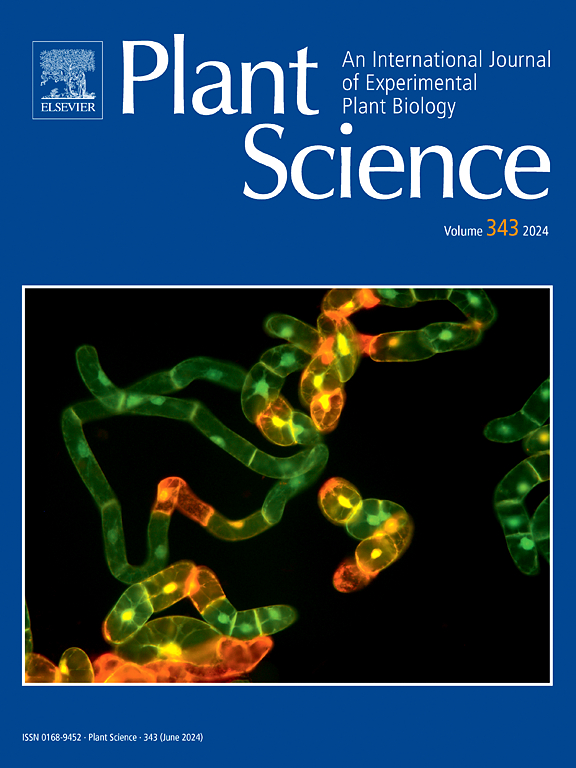ArHDZ19 contributes to drought tolerance by advancing flowering time in Anoectochilus roxburghii
IF 4.2
2区 生物学
Q2 BIOCHEMISTRY & MOLECULAR BIOLOGY
引用次数: 0
Abstract
The homeodomain-leucine zippper gene family encodes plant-specific transcription factors that not only affect growth and development, but also play important roles in the drought response. ArHDZ19, from Anoectochilus roxburghii, encodes a homeodomain-leucine zipper III subfamily protein whose function and molecule ar mechanism remains unclear. Here, we explored the function of ArHDZ19 in regulating growth and the drought response. ArHDZ19 localized in the nucleus and its expression was strongly induced under drought stress. Overexpression of ArHDZ19 in Arabidopsis thaliana (OE-ArHDZ19) not only increased plant height and the length of stamens and pistils, but also resulted in an earlier flowering phenotype. The flowering-related genes FLOWERING LOCUS T (FT), SUPPRESSOR OF CONSTANS OVEREXPRESSION 1 (SOC1), CONSTANS (CO), FLOWERING LOCUS C (FLC), and GIGANTEA (GI) were up-regulated in the OE-ArHDZ19 lines. Moreover, under drought conditions, overexpression of ArHDZ19 improved the plant survival rate and advanced the flowering time. Stress-responsive genes such as COLD-REGULATED 47 (COR47), KINESIN 1 (KIN1), and RESPONSE TO DESICCATION (RD29A) were up-regulated by drought treatment; however, their transcript levels were lower in OE-ArHDZ19 plants than in wild-type plants. These results indicate that ArHDZ19 can improve the drought resistance of plants by advancing the flowering time, which may be a drought-avoidance mechanism.
ArHDZ19通过提前开花来提高野樱草的耐旱性。
homedomain- leucinezipper基因家族编码的植物特异性转录因子不仅影响植物的生长发育,而且在干旱响应中发挥重要作用。ArHDZ19编码同源结构域亮氨酸zipper III亚家族蛋白,其功能和分子机制尚不清楚。本研究探讨了ArHDZ19在调节植物生长和干旱响应中的作用。ArHDZ19定位于细胞核,干旱胁迫强烈诱导其表达。ArHDZ19在拟南芥中的过表达(e -ArHDZ19)不仅增加了植株的株高和雄蕊、雌蕊的长度,而且使开花表型提前。OE-ArHDZ19株系开花相关基因开花位点T (FT)、CONSTANS过表达抑制因子1 (SOC1)、CONSTANS (CO)、开花位点C (FLC)和GIGANTEA (GI)上调。此外,在干旱条件下,ArHDZ19过表达提高了植株成活率,并提前了开花时间。胁迫应答基因如COLD-REGULATED 47 (COR47)、KIN1 (KIN1)和RESPONSE TO des干(RD29A)在干旱处理下表达上调;然而,它们在OE-ArHDZ19植物中的转录水平低于野生型植物。上述结果表明,ArHDZ19可通过提前开花时间提高植物抗旱性,这可能是一种抗旱机制。
本文章由计算机程序翻译,如有差异,请以英文原文为准。
求助全文
约1分钟内获得全文
求助全文
来源期刊

Plant Science
生物-生化与分子生物学
CiteScore
9.10
自引率
1.90%
发文量
322
审稿时长
33 days
期刊介绍:
Plant Science will publish in the minimum of time, research manuscripts as well as commissioned reviews and commentaries recommended by its referees in all areas of experimental plant biology with emphasis in the broad areas of genomics, proteomics, biochemistry (including enzymology), physiology, cell biology, development, genetics, functional plant breeding, systems biology and the interaction of plants with the environment.
Manuscripts for full consideration should be written concisely and essentially as a final report. The main criterion for publication is that the manuscript must contain original and significant insights that lead to a better understanding of fundamental plant biology. Papers centering on plant cell culture should be of interest to a wide audience and methods employed result in a substantial improvement over existing established techniques and approaches. Methods papers are welcome only when the technique(s) described is novel or provides a major advancement of established protocols.
 求助内容:
求助内容: 应助结果提醒方式:
应助结果提醒方式:


